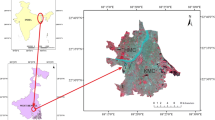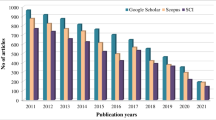Abstract
This research paper presents development of a new spectral index, it was proposed to extract the built-up area from medium spatial resolution satellite imagery data; a Landsat Operational Land Imager, and the Thermal Infrared Sensor “OLI_TIRS”. The newly developed spectral index was derived from Band ratios, it was compared with four previously used spectral indices; the Band Ratio for Built-up Area (BRBA), the Normalized Built-up Area Index (NBAI), the New Built-up Index (NBI) and the Normalized Built-up Index (NDBI). Indices were applied to extract built- up area of Djelfa city, South Algiers, in the central part of North Algeria. The results indicated that newly developed spectral index for extract the built-up area, using overall accuracy and kappa coefficient, are superior as compared to ones of the other spectral indices.





Similar content being viewed by others
References
Biraud-Burot, I. (2005). Etudier la ville à travers le prisme de la végétation. Thèse de doctorat, Ecole Doctorale de Géographie de Paris, Université Paris-Sorbonne, Paris IV, Paris. P.331.
Bouziani, M., Goïta, K., & He, D.C. (2007). Change detection of buildings in urban environment from high spatial resolution satellite images using existing cartographic data and prior knowledge. IEEE International Geoscience And Remote Sensing Symposium, Barcelona, Spain.
Cabral, P. (2007). Délimitation d’aires urbaines à partir d’une images satellitaire ETM+ : comparaison de méthode de classification. Journal Canadien De Télédétection, 33(5), 422–430.
Cabral, P., Gilg, J.-P., & Painho, M. (2005). Monitoring urban growth using remote sensing, GIS and spatial metrics. In: Proceedings of SPIE Optics & Photonics: Remote sensing and modelling of ecosystems for sustainability. San Diego, USA.
Caloz, R., & Collet, C. (2001). Précis de la télédétection, volume 03 : Traitement d’images numériques de télédétection, Production d’images non spectrales, Propriétés des indices (pp. 217–270). Presses de l’Université du Québec/AUF.
Chen, X. L., Zhao, H., Li, P., & Yin, Z. (2006). Remote sensing image-based analysis of the relationship between urban heat island and land use/cover changes. Remote Sensing of Environment, 104, 133–146.
Congalton, R. G. (1991). A review of assessing the accuracy of classifications of remotely sensed data. Remote Sensing of Environment, 37, 35–46. doi:10.1016/0034-4257(91)90048-B.
Gluch, R. (2002). Urban growth detection using texture analysis on merged Landsat TM and SPOT-P data. Photogrammetric Engineering and Remote Sensing, 68(12), 1283–1288.
Gong, P., & Howarth, P. J. (1990). The use of structure information for improving land-cover classification accuracies at the rural–urban fringe. Photogrammetric Engineering and Remote Sensing, 56(1), 67–73.
Harris, P., & Ventura, S. (1995). The integration of geographic data with remotely sensed imagery to improve classification in an urban area. Photogrammetric Engineering and Remote Sensing Journal, 61(8), 993–998.
Jieli, C., Manchun, L., Yongxue, L., Chenglei, S., & Wei, H. (2010). Extract residential areas automatically by new built-up index. 18th 2010 International Conference on Geoinformatics. IEEE, 1–5.
Mesev, V. (1998). The use of census data in urban image classification. Photogrammetric Engineering and Remote Sensing, 64(5), 431–436.
Shaban, M. A., & Dikshit, O. (2001). Improvement of classification in urban areas by the use of textural features: the case study of Lucknow city, Uttar Pradesh. International Journal of Remote Sensing, 22, 565–593.
Waqar, M. M., Mirza, J. F., Mumtaz, R., & Hussain, E. (2012). Development of new indices for extraction of built-up area & bare soil from landsat data. Open Access Scientific Reports, 1(1), 4.
Weber, C. (2001). Remote sensing data used for urban delimitation. In remote sensing and urban analysis (pp. 155–167). London: Taylor and Francis.
Zha, Y., Gao, J., & Ni, S. (2003). Use of normalized difference built-up index in automatically mapping urban areas from TM imagery. International Journal of Remote Sensing, 24(3), 583–594.
Zhang, Q., Wang, J., Peng, X., Gong, P., & Shi, P. (2002). Urban built-up land change detection with road density and spectral information from multi-temporal Landsat TM data. International Journal of Remote Sensing, 23(15), 3057–3078.
Acknowledgments
The authors would like to thank the editors and anonymous reviewers for their valuable comments and insightful ideas.
Author information
Authors and Affiliations
Corresponding author
About this article
Cite this article
Bouzekri, S., Lasbet, A.A. & Lachehab, A. A New Spectral Index for Extraction of Built-Up Area Using Landsat-8 Data. J Indian Soc Remote Sens 43, 867–873 (2015). https://doi.org/10.1007/s12524-015-0460-6
Received:
Accepted:
Published:
Issue Date:
DOI: https://doi.org/10.1007/s12524-015-0460-6




